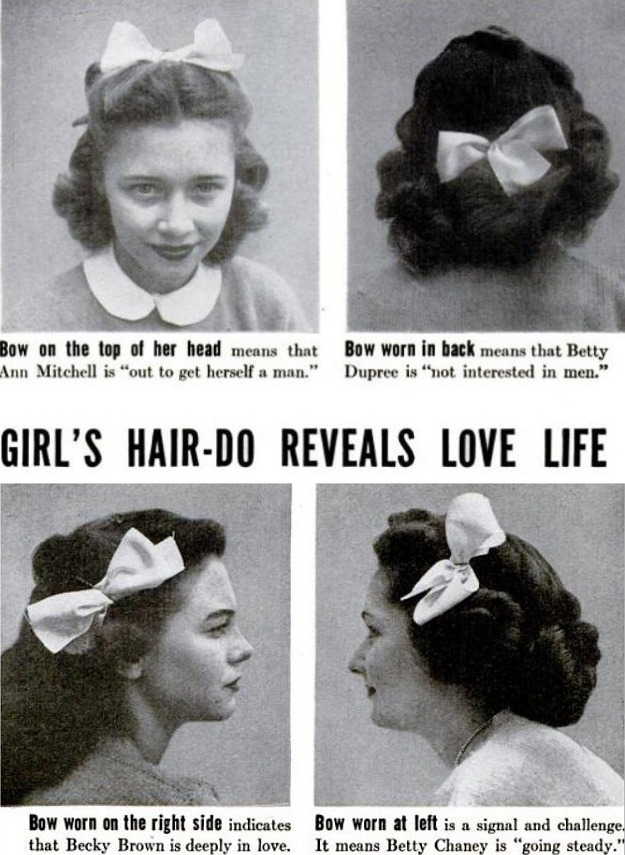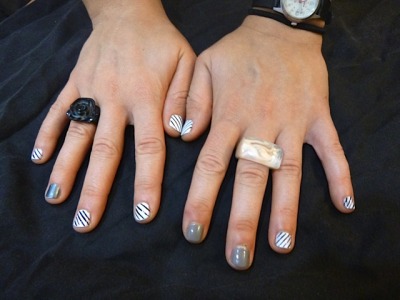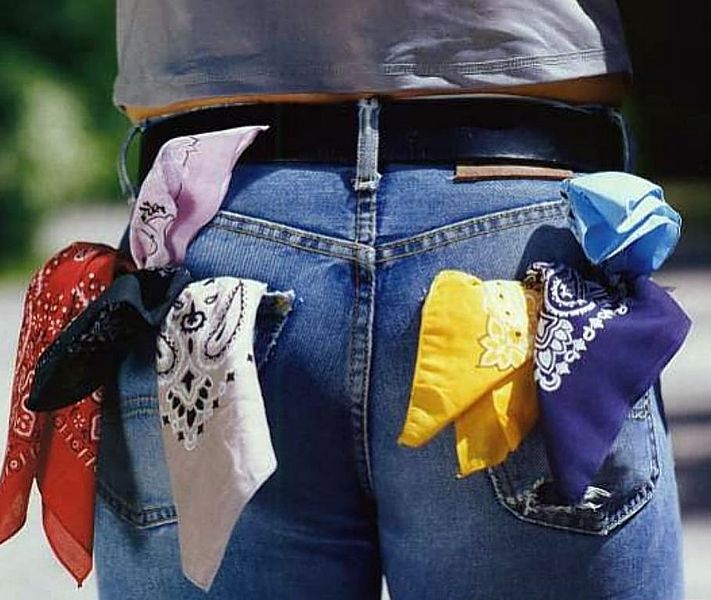Humanity has a long history of attempting to signal things
to each other without using words. For all our obsession with language, we have
found it’s often much more practical to create visual codes, as a kind of
shorthand for what we can’t, or don’t want to say.
The simplest example I can think of is the truce flag. A
white flag, or just a scrap of your dead friend’s tunic that happens to be normally
white, signals to the people you are fighting, “Oh god, oh god, stop killing me
and everyone I know, we give up.”
 A more complicated example is the language of heraldry – a complex
system of symbols and patterns designed to signal to other people, “I’m kind of
a big deal.” But more than that, the symbols, where they are placed, and the
colours used can signal all kinds of
extra detail. A certain type of crown signals, “I’m kind of a big deal because
my brother is the King.” A wavy blue line can signal “I’m kind of a big deal
because my family has a sweet beachfront castle.” This site has a great list of the more generally agreed on meanings assigned to the various animals, lines, and flowers that are used in heraldry.
A more complicated example is the language of heraldry – a complex
system of symbols and patterns designed to signal to other people, “I’m kind of
a big deal.” But more than that, the symbols, where they are placed, and the
colours used can signal all kinds of
extra detail. A certain type of crown signals, “I’m kind of a big deal because
my brother is the King.” A wavy blue line can signal “I’m kind of a big deal
because my family has a sweet beachfront castle.” This site has a great list of the more generally agreed on meanings assigned to the various animals, lines, and flowers that are used in heraldry.
In Victorian times, there was even a language associated
with what flowers you gave people.If you wanted to tell someone they were beautiful, you'd give them a rose or an orchid. If you wanted to tell them that their beauty was the only thing they had to offer, you'd send them a Japan Rose. Some of them are pretty self explanatory - if you wanted to express to someone they had betrayed you, you'd send them Judas Tree. But some of the listed meanings are pretty inscurtable to the modern eye - for example to indicate doubt, or distrust, you'd send apricot flowers.
As overly complex and perhaps frivolous as these languages seem out of context, at the time they served very important purposes. In the medieval era, it simply wasn’t practical to list off
your entire lineage on a first meeting with every person you came across – but your heritage was often what got you where you need to be, and your
heraldry could do list it off for you. In Victorian times, it was impolite to say
practically anything out loud, particularly anything emotional, and so they
communicated with flowers instead.
 |
| An example of teenage flagging from I Love Charts |
Of course, the other reason to use a visual code instead of
words is because you want to say something covertly. Teenagers have always been
obsessed with finding ways to say things covertly, and there are some fascinating
examples of this in various teen age subcultures, even if you exclude the more
obvious examples of fashion grouping like Goths, punks, or drapes. Pins, hair
bows, sleeves, all sorts of things were used in various complex codes to signal
messages to other teenagers “in the know”.
What was being signalled was almost always “Yes, you can hit on me”, or “Don’t
even think about it”, but the principle is the same.
In more modern society, there is an example of visual signalling
that combines all three of these motivations - the practice of flagging, otherwise known as
the Hankie Code. I imagine most of you would have at least heard of the hankie
code in passing, but in case you haven’t, here is a very brief rundown. In San
Francisco in the mid eighties, a cruising culture developed where gay men
started actively congregating in public. Finding themselves in a society where
it was at best, impolite, and at worst, extremely dangerous to say out loud
that you were gay, the practice arose among gay men of wearing your keys on the
left or right loop of your belt to indicate you were gay, and either a top or a
bottom.
A local journalist is credited with jokingly suggesting
that they start using different coloured hankies or bandanas to signal not only
their gender preference, but their sexual preferences as well. A code emerged,
linking different colours of bandana to different sexual fetishes. The practice
of wearing them on the left or right to indicate being a giver or receiver of
that particular fetish remained, but the specific meaning of each colour varied
enormously from region to region, and scene to scene. I won’t go into the
details here in case you happen to be reading this at work, but there are
several comprehensive lists around if you’re interested in finding out
more.
Since it’s inception, the hanky code has spread to the kink community,
which is where I came across it. The kink community has a lot in common with
the queer community – there are a lot of things we would like to say to those
around us that we can’t say out loud; because it would be inappropriate, make
us targets for harassment, or because it’s just too complicated to fit into a
first conversation.
Flagging isn’t just about signalling that you’re available,
and what you’re available for. It’s also about solidarity – signalling to other
people that you’re like them, that they’re not alone. I honestly don’t know how
to express just how crucial this feeling of community, of solidarity is. If you’ve
always felt normal, then I don’t think
you can imagine how essential it is to
know that it’s not just you, that other people feel the things you feel. But
then, I don’t know how many people have actually always felt normal. I think
everyone has something they feel is weird, or abnormal – whether it’s as
challenging as being queer, or as simple as being into stamp collecting when
everyone else thinks it’s just scraps of paper.
While I would very much like to be able to flag my interests
to those around me in order to access some of this delicious solidarity, as a queer,
poly femme, I have run into a couple of issues as to just how to go about this.
Since I very rarely wear pants, hankies are pretty impractical - although there
are makers like this who have come up with flower shaped pins made of
variously coloured hankies to address just this problem. But even if I did wear
pants or use these hanky flowers, the colours that are most commonly recognised
don’t really apply to what I want to say. I don’t have much use for the kink meanings
in the hankie code- if I’m actively seeking a kink play partner I’m almost
always out at a club specifically FOR kink, so the “kinky” part is pretty safe
to assume. If I want to signal a specific preference, I’ll just look for the
person doing what I would like to do, and ask them, or ask someone I know to recommend
someone. This works because the Sydney scene is ludicrously small and inbred –
I imagine in a larger scene it would be much less straightforward.
But when it comes to scoping other queers, I’m totally lost.
Not only do I almost always look like the stereotypical Straight Woman (long
hair, skirts, girly shoes and pretty nails), I’m also almost always out with my
boy. Say we’re at a cafe, and a gorgeous waitress starts chatting to me about
my Mass Effect character, and I would really, really like to give her my number.
How do I signal in a discreet way that a) I would like to touch her boobs even
though I look like I’m straight and b)
My desire to touch her boobs has nothing to do with impressing or titillating
my boy, and in fact I would prefer it if he wasn’t there. That’s way too much
to write on the bill.
Happily, I’m not the only one to have been mulling this over.
The lovely Laura Luna twigged me to a trend that went through the queer
activism community a little while ago based around flagging using nail polish
colours instead of hankies. There is a tumblr set up to showcase examples and
discussion of what colours should mean what, but if you do some quick searching on Google you will quickly come across an enormous array of examples and discussion.
 |
| From the Femme Flagging tumblr |
While I’m a bit
behind the curve with this trend, I’d like to give it some exposure anyway
because I think it’s a really great idea that should be more widely embraced. I
also really dig the way this trend has appropriated what the nail community
usually refer to as “feature nails” (having one nail on a hand a different
colour or design to the rest) and given
it social implications. I have always been a big fan of this kind of
appropriation – to me it harks back to the teenagers putting their hair bows in
certain places to add implication to something others thought was entirely
frivolous.
The other reason I really want to give some signal boost to
this idea is that a visual language takes time and consensus to develop. Unlike
heraldry, there is no specific organisation to sit down and set out the rules
for everyone to follow. But a language is of no use unless people understand
it, so we can’t all just decide for ourselves what we want to signal with what,
because there will be no-one else who can understand what we’re trying to say.
I don’t feel like I’m involved in the queer community enough
to add an opinion on what the visual signals used should be. But I do think it’s
a great idea, and would like to do what I can to encourage an ongoing
discussion. Partially because I would really like a way to tell that cute
waitress I’m inclined her way without having to announce it across the cafe,
but also partially because I would like a way to express to other queer femmes
that I am with them, that I’m here and I feel what they feel.
 |
| Illamasqua Baptise, a home made pink, and Darling Diva Bitch Panties |
So here is my attempt to flag femme. The code itself is
still very much under discussion, but the colours I chose were purple, which is
generally accepted to signal poly, and a sparkly pink feature nail. Sparkly
pink is apparently used to signal either a unicorn (someone who is interested
in a relationship with an existing couple) or simply “fuck patriarchy”, and I
figured either way I’m happy to signal that. I actually had to mix a pink
because I don’t own any – I’m not that kind of femme. But if this thing takes
off, I would be happy to invest in one just for this purpose.
What about you? Would you be interested in using this sort
of signalling? Do you have a different suggestion? I’d love to hear some
discussion about this.


Ohhh were do i find these flagging codes??
ReplyDeleteSo love the idea of nail polish flagging
There still seems to be a lot of discussion around what codes to use, exactly. Some femmes feel like the traditional hanky code is too...well, man-centric. If you have a trawl through the tumblr there are a couple of suggestions that seem to be agreed on. eg purple for poly and/or genderqueer.
ReplyDeleteI'm a bit late to the game of femme flagging ,but I'm so glad that someone took the time to do it. I wish that I knew of this when I was in high-school. It would've saved me a lot of pain and embarrassment. Anyhow, my only quibble with the chart is that it isn't specific enough meaning that the chart needs to be refined so as not to confuse trying to brag the attention of a lady mistaking her as a femme seeking femme when she's actually really just a straight female with great taste in nail colors! Having said that, thank you for bringing this trend to my attention. Much appreciated. Just needs a little refining for the LGBTQ community so that noone is mistaking anyone's kinky cues and trying to hit on someone thinking they're gay when they're not. Thanks! ;-)
ReplyDeleteYou're very welcome! I agree the code needs a lot more...codification? before it will be truly useful, but it's a great idea. Sometimes I think the original flaggers had it much easier - the leather community was so much smaller, so much less interconnected, it must have been much easier to reach a consensus.
Delete